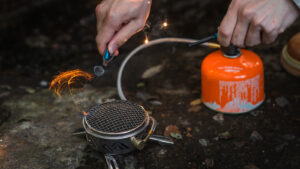Titanium vs Canister Stove Backpacking: A Detailed Comparison
Share:
The stove you pack will dictate your outdoor experience. The two common types of stoves are titanium and canister. The question they usually ask themselves is which one of the two is superior for their adventures. This distinguishes them from aluminum stoves and other heavier options available on the market. On the other hand, canister stoves provide convenience and simplicity.
This post will compare Titanium vs Canister stove in terms of weight, fuel efficiency, and boil time. Fuel efficiency matters a lot since it determines how much you have to carry around with you all day while on a hike. Boil time could also affect your overall camping experience. By looking at these factors, we will help you pick out which torch fits your backpacking requirements best.
Why Choosing the Right Stove Matters for Your Backpacking Adventure
It is important that you choose the right stove after comparing Titanium vs Canister stoves for backpacking purposes because it affects how heavy your load is.
The weight of a stove is one of the most significant factors in deciding which fits your needs best. Every single ounce counts when it is on your back with the gear. A titanium stove is one such design that is ultra-lightweight.
Fuel efficiency is another key aspect to consider. Titanium stoves tend to use solid fuels or alcohol, which weigh less but may burn poorly at low temperatures. Canister stoves work well with any propane/butane mix.
Comparing Durability, Versatility, and Environmental Impact of Titanium vs Canister Stoves

Picking the right titanium canister stove for you is not just about weight, fuel efficiency, and boil time. When durability is also one of the highlights, such stoves, known immensely for their durability, should not be left behind.
Durability:
Titanium stoves, in particular, are known for their strength. Due to titanium being highly resistant to corrosion, these stoves can last for a long time in harsh environments.
They do not bend even when subjected to rough handling or even fall at very high temperatures. This makes them extremely durable and hence suitable for backpackers who require reliable gear on difficult trails.
Canister stoves are generally sturdy but are far from indestructible. Moving parts such as valves and regulators incorporated into their designs often wear out easily because of usage over time. Field repairs are usually impossible if any of these components become faulty, which exposes the user to significant disadvantages, especially during extended trips.
Versatility:
Another thing that matters is how versatile it is. Titanium stoves commonly utilize different types of fuels, such as alcohol, wood, or solid tablets. In certain situations, this flexibility may be useful where one type of fuel might be more accessible than another, but these versions have few cooking choices.
Cooking with canister stoves is often easier, enabling you to do a range of things. This makes them good for those who like more complex trail meals. However, their dependence on proprietary fuel canisters may be a drawback in remote areas.
Environmental Impact:
This should also consider the environmental impact. Canister stoves, when disposed of, also emit carbon, and empty fuel canisters go to landfills instead of being recycled—most backpackers are bad about properly disposing of these. We currently have a few recycling programs in place, but the actual recycling rate is extremely low.
In direct contrast, titanium stoves powered on renewable fuels (i.e., wood) can create a green formula. They produce less waste and will keep you right in line with eco-conscious backpacking protocol.
Titanium stoves are long-lasting, whereas canister stoves offer plenty of options for cooking. It’ll come down to what you want specifically and what environments you will be going into.
Titanium Stove vs Canister Stove Backpacking Weight Comparison
Now let’s compare titanium vs canister stoves by weight.
Titanium Stoves:
Ultralightweight is the term used famously for titanium stoves. A typical one-ounce (28-gram) titanium alcohol stove may weigh as little as 0.5 ounces (14 grams). If you consider a windscreen and fuel bottle, the whole system might get to around three to four ounces (85–113 grams).
Canister Stoves:
It is usually heavier than titanium stoves in general canister stoves. It is normally within a range of 2.5 to 4.5 ounces for a canister stove. However, the actual difference in weight occurs due to the presence of the fuel canisters.
A small, four-ounce (110-gram) full-fuel canister weighs about 7.4 oz (210 g). On being fully larger eight oz (220g) cans have approximately 13.1 oz (371 g).
Weight Comparison:
Normalized for a weekend trip, the above titanium alcohol stove setup would weigh 6–7 ounces (170–198 grams) including fuel. The canister stove system for the same trip, meanwhile, might exceed 10–12 ounces (283–340 grams).
However, the weight difference would likely decrease somewhat on longer trips. Since titanium stoves consume fuel by volume, this can be a substantial burden on long trips.
So, the bottom line is that titanium stoves can usually have a substantial weight advantage over them, especially if used for shorter trips.
Titanium Stove vs Canister Stove Backpacking Fuel Efficiency
Titanium Stoves:
When it comes to titanium stoves, the fact that they are lightweight and use fuel efficiently is quite well known. Solid fuel tablets or alcohol usually form the basis of the majority of such stoves. In comparison, solid fuel tablets burn thoroughly without leaving much waste behind. This efficiency makes it possible for campers to calculate how much fuel they have to carry, which in turn helps them reduce unnecessary weight.
Alcohol stoves, on the other hand, are another commonly used type of titanium stove that saves a lot on fuel costs. Denatured alcohol is a light and effective fuel source.
Nevertheless, its heat output is lower than that of canister fuels. Therefore, longer periods are taken in cooking, while at the same time, a reduction in the total amount of carried firewood may be achieved.
Wind resistance is one area where titanium stoves stand out from alternatives. Often, they integrate windscreens into their designs so as to maintain efficiency even under difficult weather conditions, thus minimizing fuel waste due to drafts.
One minor problem with titanium stoves is their limited flame control ability. Most models operate only at one heating rate, which leads to waste when simmering has to be done using more powerful gas inflow levels than necessary. However, this drawback may not be significant for hikers who mainly boil water.
Canister Stoves:
The majority of canister stoves function by using pressurized liquid gas containers with propane—isobutane blends being very popular examples. Consequently, a canister stove often requires less fuel per unit of weight to cook the same meals.
One positive aspect of canister stoves is that they have an adjustable flame. This implies that backpackers can adjust their rate of fuel consumption depending on the activity at hand. If you simmer efficiently, you will save a lot of fuel over a long hiking trip.
Another disadvantage revolves around measuring the remaining amounts of gas. This uncertainty often leads to carrying extra fuel, perhaps undermining some of these efficiency measures. Further, such types of burners may not work well in extremely cold temperatures or at high altitudes, thus affecting their fuel efficiency in these states.
Titanium and canister stoves are both representatives who offer different ways to make good use of energy resources. Hence, one must consider his or her individual needs regarding outdoor cooking preferences, including style, when deciding between these two options.
Boil Time Comparison Titanium Stove vs Canister Stove
Boil time is a big deal when it comes to choosing a backpacking stove. It affects food preparation, fuel usage, and your general experience. Let’s compare the boil times between titanium and canister stoves.
Titanium Stoves:
Titanium stoves, particularly those that are alcohol- or solid-fuel-based, generally have slower boil times. For example, in optimum conditions at sea level, a titanium alcohol stove may take 7–10 minutes to boil one liter of water. If you use solid-fuel stoves, it will even take longer for them to reach boiling point, often ten to twelve minutes. Boil times change due to factors such as wind and altitude.
Despite their longer boil times, however, titanium stoves tend to perform better at higher altitudes and lower temperatures found in cold environments. Their boil times may slightly increase during these conditions, but this seldom happens as compared with canister stoves.
Canister Stoves:
When it comes to speed, though, canister stoves win hands down. In fact, most canisters usually take around 3-5 minutes for a maximum quantity of 1 L of water at sea level to be boiled. This is made possible by the pressurized fuel, which produces an intense flame. Moreover, several canisters on offer allow one to adjust the flame so that it gives maximum heat output for quicker boiling.
However, it can be difficult for the canister stoves to perform in cold temperatures and at high altitudes. When the pressure within a canister drops, boiling times may be significantly slower.
Practical Considerations:
While you will find that the canister stove offers faster boil times, it is important to consider your needs. If you are hiking alone, the increase in boiling time of a titanium stove may be worth its lighter weight.
Conversely, speed is important when cooking for groups or in a time crunch; thus, quicker types of canister stoves will ensure this.
Remember that things such as wind, temperature, and altitude will affect the boiling duration of both stoves. However, when safe, using a windscreen could provide some improvements.
Boiling time does matter, but it is just one factor among many. Consider weight, fuel efficiency, and what you need from your backpacking experience when choosing between titanium and canister stoves.
FAQs:
Which stove is better for cold weather: titanium or canister?
Canister stoves tend to perform better in cold weather because of their consistent fuel performance. However, titanium stoves would not work well in extreme cold, thus making them unsuitable for freezing conditions.
Do canister stoves have a faster boil time than titanium stoves?
Yes, water boils faster in a gas cylinder-type cooker, and it takes 3-5 minutes per liter to boil water.
At high altitudes, which type of stove should we choose?
Canister stoves are generally better for high-altitude cooking as they maintain consistent fuel pressure, which helps them perform well even in thinner air. A titanium stove may have difficulty doing so under these conditions. Irrespective of whether it can use kerosene or gasoline instead of butane and propane, that means you’ll need to fill up more often.
Do canister stoves need less upkeep than titanium stoves?
Yes, they do—canister stoves need less maintenance in general. They need fewer cleanings and adjustments, which makes them more user-friendly over the long term.
Will I be able to use a titanium stove in my tent and cook during bad weather days?
The use of a titanium stove inside your tent is generally not recommended, as this can lead to carbon monoxide poisoning and fire hazards. Most portable stoves, including titanium ones, must be used in a well-ventilated area. When you are caught in a storm and must cook inside, ensure your tent is adequately ventilated to avoid carbon monoxide poisoning.
Conclusion:
If you will use your stove for backpacking, there is a good case; it may come down to titanium or canister stoves. For those hikers who go as light as possible, they can get away with using a titanium stove that only weighs an ounce or two. Still, their performance in the cold and boiling periods is slower than average. On the other hand, canister stoves provide faster cooking during extreme weather conditions.
This, however, increases weight due to the fuel cans it requires. For instance, how long will your trip take? What is the climate like? And what type of food will you cook? However, when all’s said and done, go for a stove that considers both weight and fuel efficiency and performance. Also, be sure of your choice while making a comparison of Titanium vs Canister Stove because this will lead to having maximum fun in your outdoor endeavors.
ODM service
Looking for reliable camping stove supplier? At Deermaple, we specialize in ODM service, offering high-quality, innovative titanium or canister stoves tailored to your needs.
If you are interested in camping stove wholesale , please contact us.
Disclaimer: This blog may contain user comments, opinions, and other user-generated content. We are not responsible for the accuracy, reliability, or opinions of user-generated content. User-generated content represents the opinions of the individual authors only and does not reflect the views of this website.
Afira Waheed
Related Posts
Related Products
No products found.













